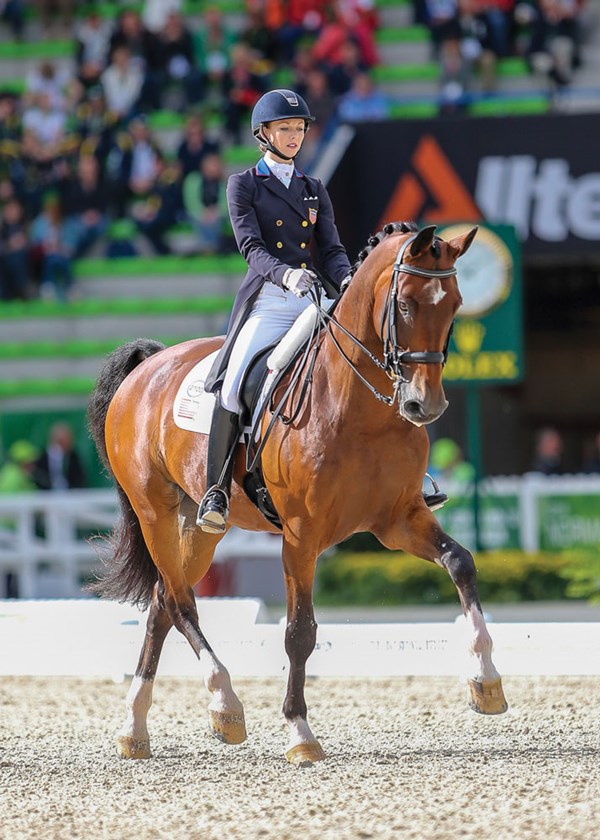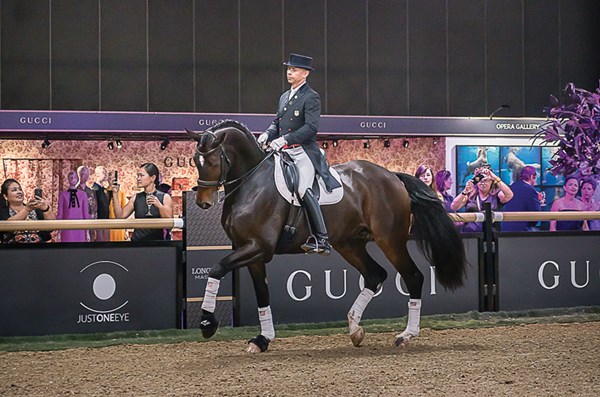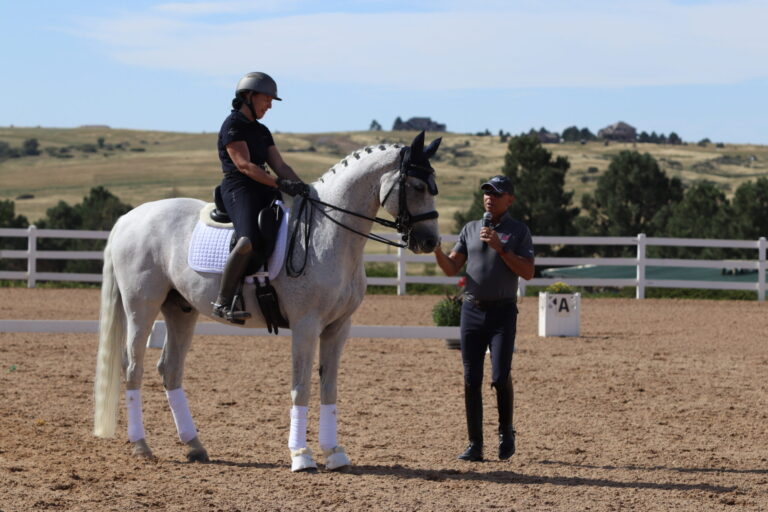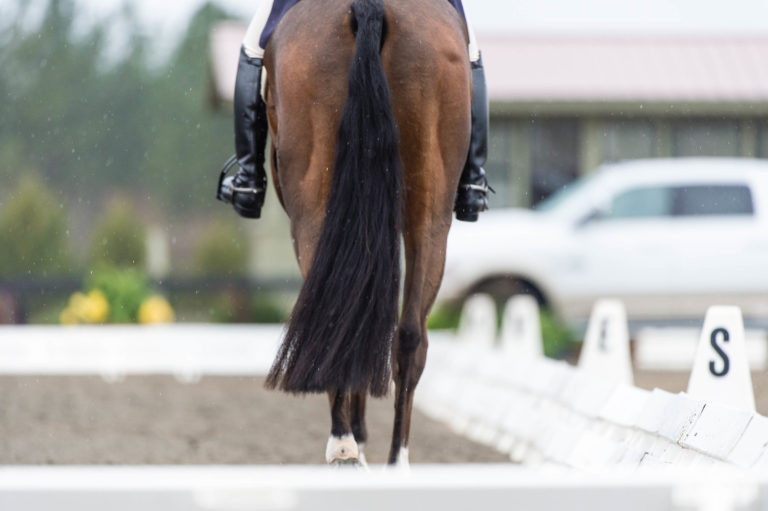It was an honor and a challenge for me to write this month’s column on two Olympic competitors, Laura Graves and Steffen Peters, both top riders who are always a joy to watch.
First, I’d like to take this opportunity to point out that looking at the chosen pictures, you can already clearly see that although they are both brilliant riders, they are two very different athletes. That is one of the very unique aspects of riding: The top athletes can and must be unique. Also, there are very few Olympic disciplines in which men and woman can compete together. In riding, we do have a true equal competition between the two genders. Where men may typically have more strength, women tend to have more feel. High-level dressage performance requires feel, coordination and quick reactions—which is more than mere strength. Observing these two photos side by side also highlights another unique aspect of equestrian sport in the Olympics. As you will notice, there is quite a big age difference between Laura and Steffen. In this sport, you can still improve as you get older. In the last Olympics in London, the Japanese dressage rider Hiroshi Hoketsu was over 70 years old! In riding, no extreme strength or flexibility is needed and so it is possible for riders of such a big age group to compete together. Experience and knowledge of the older riders seem to be just as valuable as the elasticity and flexibility of the younger athletes.
The biographies of Steffen and Laura could hardly be more different. Steffen grew up to be a professional rider and has been riding and training with the classical German education and continuing this in his own training yard with the help of good sponsorship. He has competed at three Olympics and has immense knowledge and experience in the whole field of horsemanship.
Laura and her horse, Verdades, are a very unique story. He is her only horse and she has owned him since he was a youngster. Some articles describe their story as a fairy tale come true. Building a horse from foal to Grand Prix is a journey of ups and downs that only few riders can experience. Laura may not have the experience of training many horses to this level, but she has this very special relationship with her horse that you seldom find—but if you do, it shines through in every ride.
Laura Graves and Verdades
In this picture of Laura and Verdades it is so clear how special their relationship is. They are both fully concentrating and they create an impression of power, lightness and joy that makes me want to smile immediately. Looking closely, you can see how well the horse is aligned. The powerful engine of his hindquarters creates energy that seems to flow straight through his body, lifting his shoulders, forehand and neck. The energy seems to flow all the way into his pricked ears!

Laura is sitting beautifully balanced and her hands just seem to guide the flow of movement into the right direction. She is not holding back. She is more pushing than pulling on the rein. My father taught me to imagine that the reins are very fine glass sticks that you can only push the horse forward with, but they break when you pull and when you lose the contact, too. I really like the way the curb bit is angled correctly, as it is not unusual to see the curb bit angled too close to the horizontal. Laura’s arm seems to be part of the rein. I often tell riders with contact issues to imagine that their arm is 50 percent of the rein, and as the reins are made of leather and cannot be elastic, they need to have all the elasticity of the contact in their shoulders, elbows and wrists. Laura shows this elasticity and suppleness through her whole arm.
The impression of the picture is that Laura and Verdades are telling the world: “Here we come! You better watch out!” You can see what character and personality the horse posesses and how Laura channels this positive energy. It gives it this extra edge that gives me goosebumps to watch. I just love this picture and can only wish for this pair to continue their story and crown it with success at the Olympics.
Steffen Peters and Legolas 92
Looking at Steffen, my first impressions are: What a professional performance! Steffen’s aids are so refined that they create the maximum effect possible. This pair has such an ability to push limits while keeping the work supple and harmonious at the same time.

Here Steffen and Legolas are just beginning a half pass. Notice how Legolas is bent and how his inside shoulder is leading into the movement with good cadence and freedom. He seems to just bend and melt around Steffen’s inside leg. He finds guidance to the highest level of collection and balance within the maximum amount of lateral bend.
Steffen is known for his exceptional leg position, and I myself have witnessed this once. I was attending the USDF annual symposium, and many young horses where shown under different riders. While watching the main ring, my attention all of a sudden went to a rider who rode on a long rein just past the ring. I only saw his leg, and turned to my neighbor, Hilary Clayton, exclaiming that I was jealous of the rider’s leg position. Hilary laughed and asked me if I was sure that I didn’t recognize the rider. His young horse was unfamiliar to me, and with the helmet, I actually had not recognized that it was Steffen Peters, but I could not help but notice his legs.
Looking at this picture again, it amazes me how calm and concentrated the two look with all the glitter and bright lights around them. They seem to be in their own world. Observing Legolas’s hindquarters, I can see just how much strength and power this movement creates, yet he is in full self-carriage and balance, which can be seen in the lightness of the contact. Legolas is bent to the inside, but he is clearly led by the outside rein. Here, too, the angle of the curb bit is very nice. While Legolas’s ears are not pointed forward like Verdades’s, their position signals full concentration and sensitivity. He looks to be eager and willing to perform to his best and even beyond that. This ability to go beyond expectations and to keep pushing limits without pressure, is an essential quality of a spectacular athlete. In this picture rider and horse both show a common desire to perform to their best abilities and make it look harmonious. The fact that the United States will be represented by these two riders is a great advertisement for the sport of dressage worldwide!

Susanne von Dietze is a leader in equestrian biomechanics. A physiotherapist, licensed Trainer A instructor and judge for dressage and show jumping, she gives lectures and seminars throughout the world, including at the prestigious German Riding Academy in Warendorf. She is a native of Germany and now lives with her husband and three children in Israel, where she competes at the international level. She is the author of two books on the biomechanics of riding: Balance in Movement and Horse and Rider, Back to Back.











